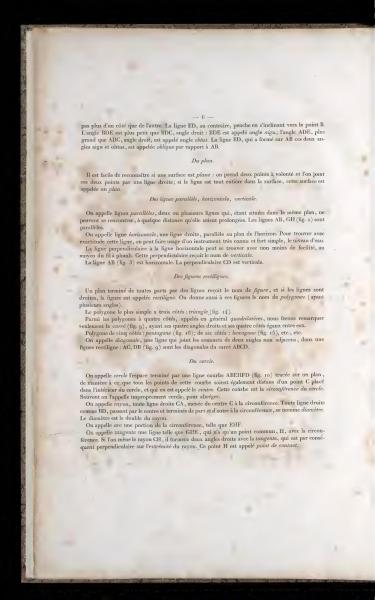The Plane.
It is easy to recognize if a surface is flat: one takes any two points and connects these two points with a straight line; if the line lies entirely on the surface, this surface is called a plane.
Parallel, Horizontal, Vertical Lines.
Lines are called parallel if two or more lines, being in the same plane, cannot meet, no matter how far they are extended. Lines AB, GH (fig. 2) are parallel.
A line is called horizontal if it is straight and parallel to the plane of the horizon. To find this line accurately, one can use a very well-known and simple instrument, the water level.
The line perpendicular to the horizontal line can be found with no less ease using a plumb line. This perpendicular is called vertical.
Line AB (fig. 3) is horizontal. The perpendicular CD is vertical.
Rectilinear Figures.
A plane enclosed on all sides by lines is called a figure, and if the lines are straight, the figure is called rectilinear. These figures are also called polygons (having multiple angles).
The simplest polygon has three sides: a triangle (fig. 14).
Among polygons with four sides, generally called quadrilaterals, we note especially the square (fig. 9), having four right angles and four equal sides.
Five-sided polygon: pentagon (fig. 16); six-sided: hexagon (fig. 15), etc., etc.
A diagonal is a line that joins the vertices of two non-adjacent angles in a rectilinear figure: AC, DB (fig. 9) are the diagonals of the square ABCD.
The Circle.
The term circle refers to the space enclosed by a curved line ABEHFD (fig. 10) drawn on a plane, ensuring that all points of this curve are equally distant from a point C placed inside the circle, known as the center. This curve is the circumference of the circle.
It is often improperly called a circle for brevity.
A radius is any straight line CA, drawn from the center C to the circumference. Any straight line like BD, passing through the center and ending on either side at the circumference, is called a diameter. The diameter is double the radius.
An arc is a portion of the circumference, such as EHF.
A tangent is a line like GHE, which has only one point in common, H, with the circumference. If the radius CH is drawn, it will form two right angles with the tangent, which is consequently perpendicular at the extremity of the radius. This point H is called the point of contact.
Translation Notes:
Plan translates directly to 'plane'; cercle translates to 'circle', referring both to the space and its boundary in contemporary English.
The text describes geometric concepts, including identifying a flat plane and defining parallel, horizontal, and vertical lines. It explains rectilinear figures, such as triangles and quadrilaterals, and illustrates terms related to circles, including diameter, radius, circumference, arc, tangent, and points of contact. These explanations help in understanding basic geometric principles in drawing and art.
